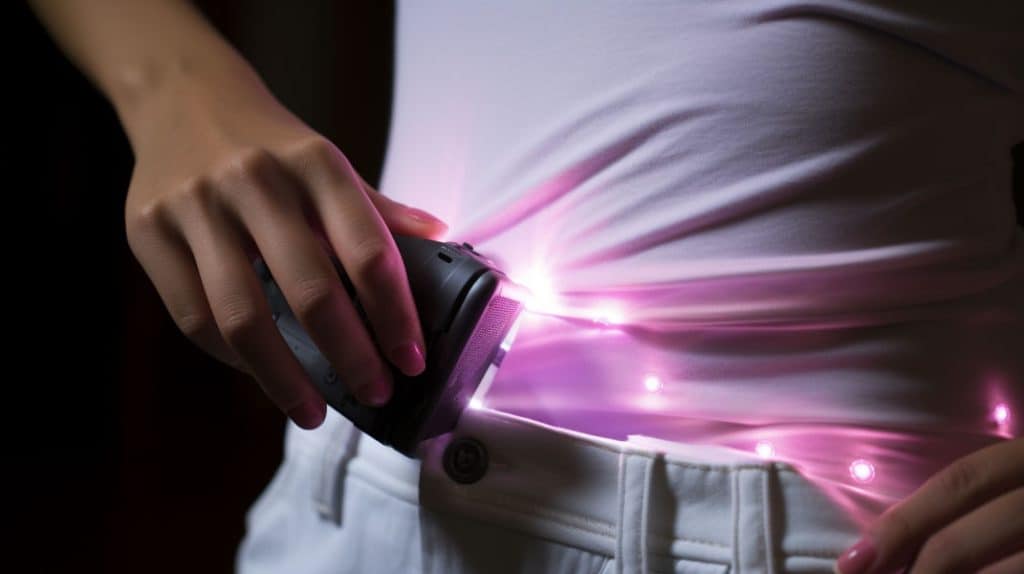Will A Stun Gun Go Through Clothes?

Definition of stun gun and how it works
A stun gun is a device used for personal protection and safety. It is a non-lethal weapon that uses high-voltage electric shock to incapacitate an attacker or aggressor temporarily.
The shock delivered by the stun gun causes an interruption in the communication between the muscles and the brain, which results in a loss of muscle control and disorientation.
The stun gun works by converting the normal battery voltage into a high-voltage, low-current electrical discharge delivered to the attacker upon contact with the stun gun.
This electrical shock creates an involuntary solid contraction of the muscles, which can last several minutes. The stun gun is an effective self-defense tool that can provide peace of mind and protection in various situations, such as late-night walks, traveling, or other high-risk environments.
Types of clothing material
Stun guns, while being a popular self-defense option among individuals, have variable effectiveness depending on the object they are being used on. Stun guns are designed to operate efficiently on soft objects such as clothes or flesh but may not perform the way one intends while aiming at hard materials such as leather or metal.
The reason is that the electrical current delivered by the stun gun may not be able to penetrate or pass through the rigid exterior surface of such objects. Hence, individuals must be aware that stun guns may not always work and exercise appropriate caution while using them in self-defense.
It is important to use stun guns judiciously to facilitate self-protection and mitigate against the likelihood of injury during an attack.
Factors Affecting Stun Guns’ Effectiveness
Various factors can affect the effectiveness of a stun gun. The first is the voltage and amperage of the stun gun. The higher the voltage and amperage, the more effective it will be in incapacitating an attacker.
The quality of the stun gun can also affect its effectiveness. Other factors include the battery charge level, the condition of the prongs or electrodes, and the level of resistance in the attacker’s body.
Length of contact with a stun gun
The length of contact with a stun gun, also known as stun time, plays a critical role in determining the effectiveness of the stun gun. The longer the stun time, the more influential the stun gun is likely to be. This is because the stun gun delivers an electric shock to the attacker’s body, which disrupts the nervous system and induces temporary paralysis.
A short stun time may not be enough to fully incapacitate the attacker, while a longer stun time can extend the paralysis and provide more time for the victim to escape. The ideal time to maintain contact with a stun gun is 3-5 seconds.
It’s essential to read the instructions for your stun gun, practice using it, and avoid overusing it. If you wish to purchase a stun gun, research and ensure that it is legal in your area and fit for your protection needs.
The quality of the stun gun
The quality of a stun gun plays a significant role in determining its effectiveness. It is essential to consider the voltage, amperage, durability, and reliability of the stun gun. A higher voltage and amperage generally means a stronger and more effective stun gun.
However, a poorly made stun gun may not produce a consistent electric charge, reducing its effectiveness. Additionally, a stun gun that is not durable or reliable may malfunction, break, or fail to operate altogether when needed.
It is important to do research and invest in a quality stun gun to ensure its effectiveness and safety in self-defense situations.
The stun gun’s voltage and amperage
The voltage and amperage of a stun gun can greatly affect its effectiveness. Voltage determines the strength of the electrical charge that is delivered, while amperage measures the amount of current flowing through the charge.
Higher voltages can cause the charge to travel farther and penetrate more deeply through clothing and into the body, while higher amperages are needed to overcome resistance in the body to deliver the shock.
The minimum voltage of a stun gun should be 25,000 volts. This would allow the stun gun to penetrate a 1/2 inch of clothing, as long as the clothing is not real dense, like leather. The ideal amperage for an effective stun gun is between 4 and 4.9 milliamps.

